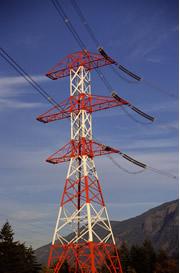 Burst of energy: schemes are needed to better manage our power supply.Photodisk
Burst of energy: schemes are needed to better manage our power supply.PhotodiskRefrigerated warehouses might soon be used to store not just food, but gigawatts of electricity. A plan dreamt up in the Netherlands could see the giant fridges acting as massive batteries. They would buffer swings in supply and demand from electricity created from renewable sources.
The idea seems simple. Say you lowered the temperature of all large coldstores in Europe by just 1°C during the night when electricity demand is low, then let it rise 1°C by switching them off during the day when demand is at peak. The net effect would be that the warehouses would act as as batteries — potentially storing 50,000 megawatt-hours of energy — and the food wouldn't melt.
That's the calculation of Sietze van der Sluis, head of refrigeration and heating technology at The Netherlands Organization for Applied Scientific Research (TNO) in Delft.
Van der Sluis is now leading a research project called 'Night Wind', to try to put the idea into practice. Together with energy research groups and suppliers in Spain, Bulgaria, and Denmark, he's looking at coldstores as a potential solution to managing the intermittent and unpredictable flow of renewable energy sources, such as wind power.
The problem with renewable power sources is that you get more electricity on a windy day than on a calm one, or on a sunny day than a cloudy one. This makes it difficult to integrate it into the grid, which must deliver a steady flow of power and deal with peak demands. As a result many renewable-power plants have to store their energy, by raising water to a height or making hydrogen, for example, so they can 'save it for a rainy day'.
Cold start
"Being a refrigeration expert, I realized the possibilities of using refrigerated warehouses as thermal energy storage and therefore as electrical energy storage," says Van der Sluis. The capacity of Europe's coldstores alone could handle more than twice the projected output of wind power in the European Union in 2010, he calculates.
Later this year, van der Sluis's team will start a demonstration project by setting up a wind turbine next to the Netherlands' largest coldstore, in Bergen op Zoom, a small town in the SouthWest of the country. It shouldn't be technically difficult, he says — it's really just a question of developing software to match the temperature of the warehouses with electricity demand, turning the fridge on and off as the supply from the wind plant and the demand from consumers change during the day.
The idea builds on something that already happens: large consumers of electricity, such as coldstores, can get reductions in their electricity costs by promising to switch off for a few minutes during periods of peak demand. The idea is to scale that up to hours instead of minutes, and to moderate it carefully to even out the energy supply.
Location, location, location
Researchers say that its too soon to tell what the potential of coldstores might be, but they aren't dismissing the idea. "It's certainly a new entrant [to this storage mix], says Roger Anderson, a grid researcher at Columbia University, adding that its difficult to judge how much energy it could buffer.
ADVERTISEMENT
"It sounds worthwhile to investigate the possibility," agrees Steven Letendre, an expert in grid storage economics at Green Mountain College in Vermont, adding that the location of coldstores in relation to grid transmission and distribution hubs might be a problem.
There are many other creative solutions in the works to store grid energy. Letendre is working on a way that owners of electric cars could use their vehicles as a giant collective battery to buffer the grid. And in Denmark, heat pumps that convert electricity to hot water are being used to balance out the supply and demand of energy.
The clever part of using coldstores is that it doesn't require much new investment, argues Van der Sluis. "The 'batteries' are already there, at no extra cost."
Visit our couldsavepowerfor_a.html">newsblog to read and post comments about this story.
Netherlands Organization for Applied Scientific Research
